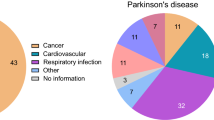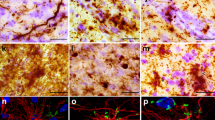Abstract
Depression is a feature of both Lewy body disorders and multiple system atrophy (MSA). Since serotonergic neurons of the rostral raphe have been implicated in depression, we sought to determine whether there is a differential involvement of these neurons in cases with clinically diagnosed dementia with Lewy bodies (DLB) or MSA. We studied the brainstem obtained at autopsy from fourteen patients with diagnosis of DLB and pathological limbic or neocortical stage Lewy body disease, 13 patients with clinical and neuropathological diagnosis of MSA, and 12 controls with no history of neurologic disease. The clinical features of these patients were analyzed retrospectively by reviewing their medical records. Serial sections were immunostained for tryptophan hydroxylase (TrOH) and α-synuclein and cell counts were performed in the dorsal raphe (DR), median raphe (MR) and medullary raphe nuclei. There was loss of serotonergic cells in both the DR and MR in DLB compared to control cases: For the DR, the number of cells/section were 53 ± 6 in DLB versus 159 ± 13 (P < 0.001) respectively, and for the MR 70 ± 11 in DLB versus 173 ± 23 (P < 0.001) respectively. In contrast, these cells were relatively preserved in MSA. The caudal raphe groups were affected both in MSA and in DLB. There is a differential involvement of raphe neurons in DLB and MSA. Although loss of rostral raphe neurons may contribute to depression in DLB, this appears to be less likely in MSA. Factors other than the neurochemical phenotype determine neuronal vulnerability in MSA.




Similar content being viewed by others
References
Aarsland D, Bronnick K, Ehrt U, De Deyn PP, Tekin S, Emre M, Cummings JL (2007) Neuropsychiatric symptoms in patients with Parkinson’s disease and dementia: frequency, profile and associated care giver stress. J Neurol Neurosurg Psychiatry 78:36–42
Ballard CG, Jacoby R, Del Ser T, Khan MN, Munoz DG, Holmes C, Nagy Z, Perry EK, Joachim C, Jaros E, O’Brien JT, Perry RH, McKeith IG (2004) Neuropathological substrates of psychiatric symptoms in prospectively studied patients with autopsy-confirmed dementia with lewy bodies. Am J Psychiatry 161:843–849
Benarroch EE, Schmeichel AM, Low PA, Boeve BF, Sandroni P, Parisi JE (2005) Involvement of medullary regions controlling sympathetic output in Lewy body disease. Brain 128:338–344
Benarroch EE, Schmeichel AM, Parisi JE (2002) Depletion of mesopontine cholinergic and sparing of raphe neurons in multiple system atrophy. Neurology 59:944–946
Benrud-Larson LM, Sandroni P, Schrag A, Low PA (2005) Depressive symptoms and life satisfaction in patients with multiple system atrophy. Mov Disord 20:951–957
Braak H, Muller CM, Rub U, Ackermann H, Bratzke H, de Vos RA, Del Tredici K (2006) Pathology associated with sporadic Parkinson’s disease-where does it end? J Neural Transm Suppl 89–97
Ding YQ, Marklund U, Yuan W, Yin J, Wegman L, Ericson J, Deneris E, Johnson RL, Chen ZF (2003) Lmx1b is essential for the development of serotonergic neurons. Nat Neurosci 6:933–938
Fornal CA, Martin-Cora FJ, Jacobs BL (2006) “Fatigue” of medullary but not mesencephalic raphe serotonergic neurons during locomotion in cats. Brain Res 1072:55–61
Galvin JE, Pollack J, Morris JC (2006) Clinical phenotype of Parkinson disease dementia. Neurology 67:1605–1611
Gilman S, Low PA, Quinn N, Albanese A, Ben-Shlomo Y, Fowler CJ, Kaufmann H, Klockgether T, Lang AE, Lantos PL, Litvan I, Mathias CJ, Oliver E, Robertson D, Schatz I, Wenning GK (1998) Consensus statement on the diagnosis of multiple system atrophy. J Auton Nerv Syst 74:189–192
Goridis C, Rohrer H (2002) Specification of catecholaminergic and serotonergic neurons. Nat Rev Neurosci 3:531–541
Halliday GM, Blumbergs PC, Cotton RG, Blessing WW, Geffen LB (1990) Loss of brainstem serotonin- and substance P-containing neurons in Parkinson’s disease. Brain Res 510:104–107
Hendricksen M, Thomas AJ, Ferrier IN, Ince P, O’Brien JT (2004) Neuropathological study of the dorsal raphe nuclei in late-life depression and Alzheimer’s disease with and without depression. Am J Psychiatry 161:1096–1102
Hornung JP (2003) The human raphe nuclei and the serotonergic system. J Chem Neuroanat 26:331–343
Kim HS, Jang HJ, Cho KH, Hahn SJ, Kim MJ, Yoon SH, Jo YH, Kim MS, Rhie DJ (2006) Serotonin inhibits the induction of NMDA receptor-dependent long-term potentiation in the rat primary visual cortex. Brain Res 1103:49–55
McKeith IG, Dickson DW, Lowe J, Emre M, O’Brien JT, Feldman H, Cummings J, Duda JE, Lippa C, Perry EK, Aarsland D, Arai H, Ballard CG, Boeve B, Burn DJ, Costa D, Del Ser T, Dubois B, Galasko D, Gauthier S, Goetz CG, Gomez-Tortosa E, Halliday G, Hansen LA, Hardy J, Iwatsubo T, Kalaria RN, Kaufer D, Kenny RA, Korczyn A, Kosaka K, Lee VM, Lees A, Litvan I, Londos E, Lopez OL, Minoshima S, Mizuno Y, Molina JA, Mukaetova-Ladinska EB, Pasquier F, Perry RH, Schulz JB, Trojanowski JQ, Yamada M (2005) Diagnosis and management of dementia with Lewy bodies: third report of the DLB Consortium. Neurology 65:1863–1872
Michelsen KA, Schmitz C, Steinbusch HW (2007) The dorsal raphe nucleus—from silver stainings to a role in depression. Brain Res Rev (in press)
Papp MI, Lantos PL (1994) The distribution of oligogendroglial inclusions in mutiple system atrophy and its relevance to clinical symtpomatology. Brain 117:235–243
Paulus W, Jellinger K (1991) The neuropathologic basis of different clinical subgroups of Parkinson’s disease. J Neuropathol Exp Neurol 50:743–755
Syed A, Chatfield M, Matthews F, Harrison P, Brayne C, Esiri MM (2005) Depression in the elderly: pathological study of raphe and locus ceruleus. Neuropathol Appl Neurobiol 31:405–413
Xiang Z, Prince DA (2003) Heterogeneous actions of serotonin on interneurons in rat visual cortex. J Neurophysiol 89:1278–1287
Acknowledgments
This study was supported by a grant from the National Institutes of Health (NS32352-P2) and Mayo Funds.
Author information
Authors and Affiliations
Corresponding author
Rights and permissions
About this article
Cite this article
Benarroch, E.E., Schmeichel, A.M., Sandroni, P. et al. Rostral raphe involvement in Lewy body dementia and multiple system atrophy. Acta Neuropathol 114, 213–220 (2007). https://doi.org/10.1007/s00401-007-0260-3
Received:
Revised:
Accepted:
Published:
Issue Date:
DOI: https://doi.org/10.1007/s00401-007-0260-3




